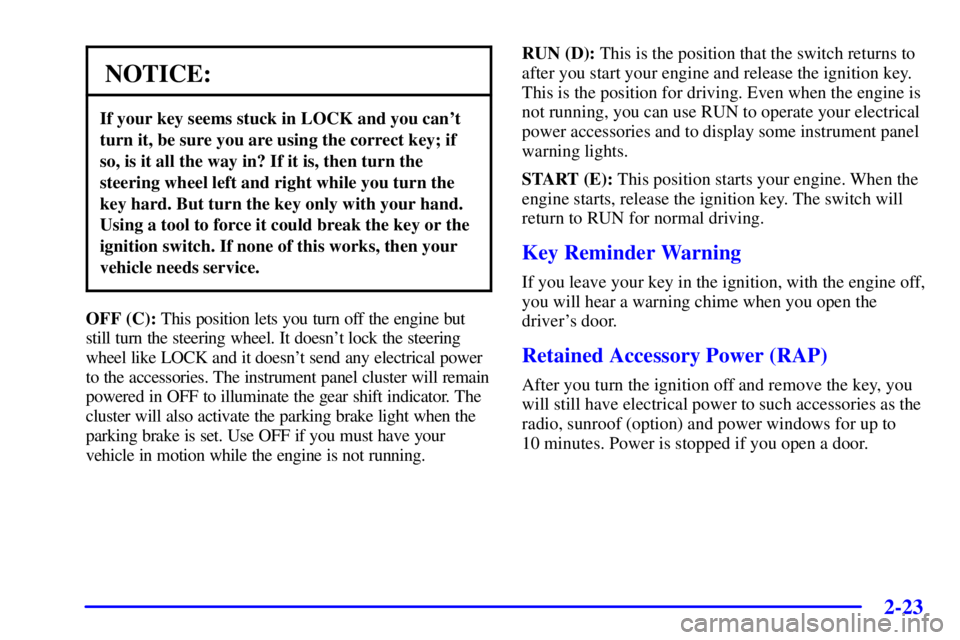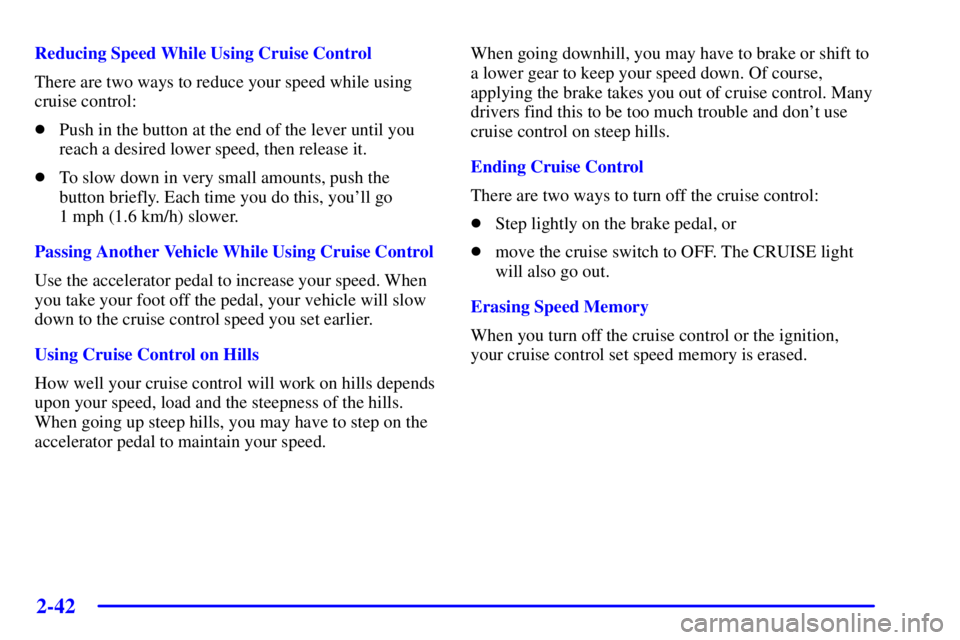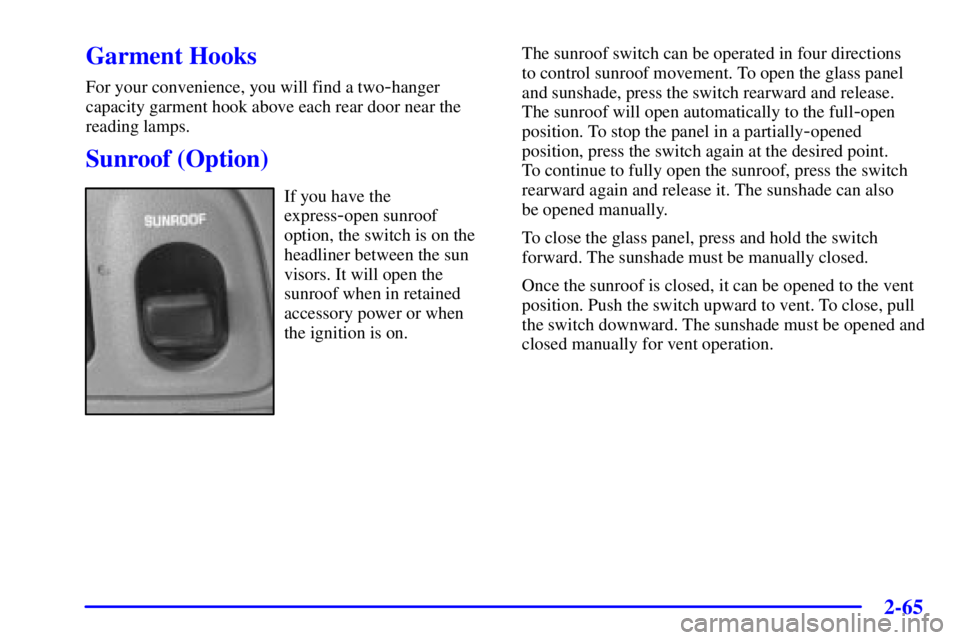Page 91 of 392

2-23
NOTICE:
If your key seems stuck in LOCK and you can't
turn it, be sure you are using the correct key; if
so, is it all the way in? If it is, then turn the
steering wheel left and right while you turn the
key hard. But turn the key only with your hand.
Using a tool to force it could break the key or the
ignition switch. If none of this works, then your
vehicle needs service.
OFF (C): This position lets you turn off the engine but
still turn the steering wheel. It doesn't lock the steering
wheel like LOCK and it doesn't send any electrical power
to the accessories. The instrument panel cluster will remain
powered in OFF to illuminate the gear shift indicator. The
cluster will also activate the parking brake light when the
parking brake is set. Use OFF if you must have your
vehicle in motion while the engine is not running.RUN (D): This is the position that the switch returns to
after you start your engine and release the ignition key.
This is the position for driving. Even when the engine is
not running, you can use RUN to operate your electrical
power accessories and to display some instrument panel
warning lights.
START (E): This position starts your engine. When the
engine starts, release the ignition key. The switch will
return to RUN for normal driving.
Key Reminder Warning
If you leave your key in the ignition, with the engine off,
you will hear a warning chime when you open the
driver's door.
Retained Accessory Power (RAP)
After you turn the ignition off and remove the key, you
will still have electrical power to such accessories as the
radio, sunroof (option) and power windows for up to
10 minutes. Power is stopped if you open a door.
Page 110 of 392

2-42
Reducing Speed While Using Cruise Control
There are two ways to reduce your speed while using
cruise control:
�Push in the button at the end of the lever until you
reach a desired lower speed, then release it.
�To slow down in very small amounts, push the
button briefly. Each time you do this, you'll go
1 mph (1.6 km/h) slower.
Passing Another Vehicle While Using Cruise Control
Use the accelerator pedal to increase your speed. When
you take your foot off the pedal, your vehicle will slow
down to the cruise control speed you set earlier.
Using Cruise Control on Hills
How well your cruise control will work on hills depends
upon your speed, load and the steepness of the hills.
When going up steep hills, you may have to step on the
accelerator pedal to maintain your speed. When going downhill, you may have to brake or shift to
a lower gear to keep your speed down. Of course,
applying the brake takes you out of cruise control. Many
drivers find this to be too much trouble and don't use
cruise control on steep hills.
Ending Cruise Control
There are two ways to turn off the cruise control:
�Step lightly on the brake pedal, or
�move the cruise switch to OFF. The CRUISE light
will also go out.
Erasing Speed Memory
When you turn off the cruise control or the ignition,
your cruise control set speed memory is erased.
Page 111 of 392
2-43
Exterior Lamps
Headlamps
This knob controls the
following systems:
�Headlamps
�Taillamps
�Parking Lamps
�License Lamps
�Sidemarker Lamps
�Instrument Panel Lights
�Interior Courtesy Lamps
Pull the headlamp knob out to the first position to turn
on the parking, license and sidemarker lamps. Pull the
knob out further, to the second position, to turn on the
headlamps. Push the knob all the way back in to turn off
the parking and headlamps.
Lamps On Reminder
If you leave the manual headlamp or parking lamp
switch on, remove the key from the ignition and open
the driver's door, you will hear a continuous warning
chime. The chime will turn off when the lamps are
turned off.
Page 112 of 392

2-44
Daytime Running Lamps
Daytime Running Lamps (DRL) can make it easier for
others to see the front of your vehicle during the day.
DRL can be helpful in many different driving
conditions, but they can be especially helpful in the
short periods after dawn and before sunset. Fully
functional daytime running lights are required on all
vehicles first sold in Canada.
A light sensor on top of the instrument panel monitors
the exterior light level for the operation of DRL and
Twilight Sentinel
�, so be sure it isn't covered.
The DRL system will make your high
-beam headlamps
come on at reduced brightness in daylight when the
following conditions are met:
�The ignition is on,
�The headlamp switch is off, and
�The transaxle is not in PARK (P).
When DRL are on, only your high
-beam headlamps will
be on. The parking lamps, taillamps, sidemarker and
other lamps won't be on. Your instrument panel won't
be lit up either.When it's dark enough outside, your high
-beam
headlamps will change to low
-beam headlamps at full
brightness. The other lamps that turn on with your
headlamps will also turn on. When it's bright enough
outside, the regular lamps will turn off, and your
high
-beam headlamps change to the reduced brightness
of DRL.
To idle your vehicle with the DRL off, shift the
transaxle into PARK (P). The DRL will stay off until
you shift out of PARK (P).
To turn off all exterior lighting at night when you are
parked, turn off the headlamps and slide the Twilight
Sentinel control all the way to the left When released,
the control will return to the Twilight Sentinel minimum
delay position and the lights will turn off.
As with any vehicle, you should turn on the regular
headlamp system when you need it.
Cornering Lamps
The cornering lamps are designed to come on when you
signal a turn. This will provide more light for cornering
at night.
Page 114 of 392

2-46
Delayed Entry Lighting
When you open the door, the interior lamps will come
on. When you close the door with the ignition off, the
interior lamps will stay on for 25 seconds or until the
ignition is turned to an on position. Locking the doors
with the power door lock switch will override the
delayed entry lighting feature and the lamps will turn
off right away.
Using the remote keyless entry transmitter to lock the
door will not cancel delayed lighting.
Theater Dimming
This feature allows for a three to five-second fade out of
the courtesy lamps instead of immediate turn off.
Delayed Exit Lighting
With this feature, the interior lamps will come on for
25 seconds after you remove the key from the ignition.
This will give you time to find the door handle or
lock switches.
Parade Dimming
This feature prohibits the dimming of your instrument
panel displays during daylight while your headlamps are
on. This feature operates with the light sensor for the
Twilight Sentinel
� and is fully automatic. When the
light sensor reads darkness outside, you will be able to
dim your instrument panel displays once again.
Perimeter Lighting
When the button with the unlock symbol on the remote
keyless entry transmitter is pressed, the daytime running
lamps, parking lamps and back
-up lamps will come on
if it is dark enough outside.
This feature will only be activated when the security
feedback feature is programmed to be in Modes 1, 3 or
5 on the transmitter. Modes 0, 2 and 4 do not respond
with exterior lights flashing when unlocking the vehicle
so perimeter lighting will not be active.
This feature can be programmed on or off for
each transmitter.
Page 116 of 392
2-48
Front Reading Lamps
These lamps and the interior courtesy lamps will come
on when you open a door. They will turn off when you
turn on the ignition.
To turn on the front seat reading lamps when the doors
are closed, press the button behind the lamp you want
on. Press it again to turn the lamp off.
These lamps work even when the ignition is off.
Rear Reading Lamps
To turn on a rear seat reading lamp, press the switch
above that rear door. To turn off the reading lamp, press
the switch again.
Page 133 of 392

2-65
Garment Hooks
For your convenience, you will find a two-hanger
capacity garment hook above each rear door near the
reading lamps.
Sunroof (Option)
If you have the
express
-open sunroof
option, the switch is on the
headliner between the sun
visors. It will open the
sunroof when in retained
accessory power or when
the ignition is on.The sunroof switch can be operated in four directions
to control sunroof movement. To open the glass panel
and sunshade, press the switch rearward and release.
The sunroof will open automatically to the full
-open
position. To stop the panel in a partially
-opened
position, press the switch again at the desired point.
To continue to fully open the sunroof, press the switch
rearward again and release it. The sunshade can also
be opened manually.
To close the glass panel, press and hold the switch
forward. The sunshade must be manually closed.
Once the sunroof is closed, it can be opened to the vent
position. Push the switch upward to vent. To close, pull
the switch downward. The sunshade must be opened and
closed manually for vent operation.
Page 139 of 392
2-71
The main components of your instrument panel are the following:
A. Air Outlet
B. Headlamps/Parking Lamps Knob
C. Turn Signal/Multifunction Lever
D. Steering Wheel Controls
E. Hazard Warning Flashers Button
F. Instrument Panel Cluster
G. Gearshift Lever
H. Audio System
I. Air Outlet
J. Fuel Door Release ButtonK. Trunk Release and Lockout Button
L. Hood Release
M. Ignition Switch
N. Traction Control Button
O. Heated Seat Controls
P. Ashtray and Cigarette Lighter
Q. Climate Control System
R. Glove Box
S. Passenger Climate Control